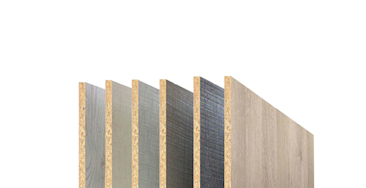

With a specific short cycle lamination
our melamine faced panels enhance their resistance to scratches, moisture, and chemicals.
Our panels enhance
are thus ideal materials for furniture applications ranging from residential decorations responding to every design needs.
Panel Plus Melamine Faced panel


Comparison between MFC and Other Surface-Covering Boards
Advantages
- cheaper than HPL
- Durable to scratches and crashes
- Easy-to-use, can be cut into pieces without any complicated process
- It will not peel off like other materials upon glue expired

Abrasion Resistance
Taber abraser applied at 60 rpm on sample surface (100×100 mm.), Insignificant reduction of sample weight.

Burning Resistance
Sample is placed in oven at 70 °c for 24 hours, No cracks.

Steam Resistance
Sample surface exposed for 1 hour to steam, Slightly change in gloss/color.

Acid Test
Sample surface exposed to 0.2 N & 4 N Hydrochloric acid respectively for 15 minutes and 24 hours testing, Slightly change n gloss/color.

Cracking Resistance
Sample is placed in oven at 70 °c for 24 hours, No cracks.

Dry Heat Resistance
A vessel containing oil at 180 °c placed on sample surface, Slightly change in gloss/color.

Stain Resistance
Sample surface exposed to various staining materials for 16 hours. Staining materials: coffee, tea, soy sauce, acetone, etc., No visible change.

Porosity
Graphite laid on sample surface, No graphite stain observed with naked eyes.
Working with melamine faced particle board
1. Linear Cutting
Cutting with Circular Saw (Equipment and Technique)

- Size of saw blade : 10″-12″ with 80 – 100 teeth
- Material of Saw Teeth : Tungsten Carbide
- Blade styles : Trapezoid teeth of alternating teeth
- Speed : 4,000 rpm per minute
- Cutting: The blade height shall not exceed 30 mm. measuring from the edge of the work piece
- Sharpening of saw blade: After cutting of 300 – 400 sheets or increased crack of the saw blades is seen.
- Feeding speed: 50-60 seconds; reduce the speed if the panel has crack
** Cutting with circular saw can cause the crack at the bottom side
Cutting with the sliding table saw main saw and scoring saw
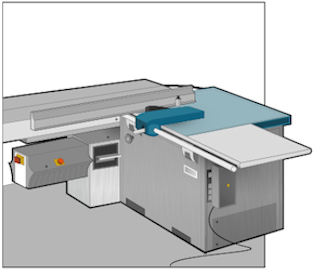
Sliding type table saw : Main saw and scoring saw
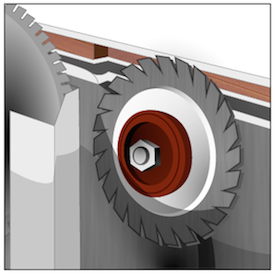
Appearance of the main saw and scoring saw
2. Cutting the melamine faced particle board in curving form

Cutting the wood in curved form in case of having the curved form
- Place the curved form as required on the melamine faced particle board.
- Trimming the edge of the melamine faced particle board with the circular saw or jig saw in the shape similar to the form.
- Cutting along the curved line of the form with the router at the speed of 9,000 – 23,000 rpm.
- The router bit shall be about 12 cm. long.
3. Crack caused by cutting
The quality of the cracked edge depends on the many factors such as no scoring saw available at the bottom, the sharpness of the saw blade, the setup distance of saw blade, the speed of the saw blade, the pushing speed to the saw blade. Normally the crack occurs on the edge bottom surface
Solution
- Trimming the edge with router: The cutting procedure shall have an allowance of the length of the melamine faced particle board at each side about 2 mm. for trimming the edge due to the crack caused by cutting, such as if you need the work piece of size 120 cm. length by 60 cm. wide, you should cut the work piece at the size of 120.2 cm x 60.2 cm.
- If the crack is just little, rub it with the sand paper or cover the edge with the paint.
- When installing it, put the cracked side on the inside such as the inside of the door.
4. Edge banding
Banding the edge with hot melted glue
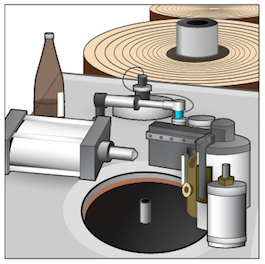
Type of the edge
- The hot melted glue will be transferred from the glue tank along the pipe into the roller.
- Set the desired length of the edge. (The machine will cut to set length automatically.
- Place the melamine faced particle board on the edge presser and press edge along the melamine faced particle board with the hand. Then dressing the edge with the cutter blade or router.
- Use the turpentine or coconut oil to clean the glue stain at the edge of the work piece.
Banding the edge with the rubber glue
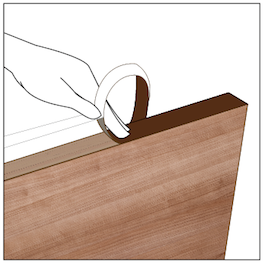
Type of the edge banding machine
- Clean the surface of the work piece
- Apply the rubber glue along the edge of the work piece
- Let it dry out for about 7 minutes
- Dovetail the desired banding edge on the work piece. The width of the banding edge shall 1.5 mm. wider than the thickness of the melamine faced particle board.
- Press the air out.
- Dressing the edge with the cutter blade or router.
- Use the turpentine or coconut oil to clean the glue stain at the edge of the work piece.
5. Fastening the melamine faced particle board with the screw

Fastening the melamine faced particle board with the screw.
- Use screw for wood. The diameter and the length of the screw depend on the thickness of the woods to be dovetailed.
- Pre-drilling the hole with the drilling machine.
- Use the drill to drill the screw through the bottom of the work piece so that you feel that it fastens very well.
The difference of the screw type

Type of the screw for wood : spiky screw

Type of screw for metal : round tipped screw
Recommendation for a proper selection of screws:

Measuring the length of the screw and the work piece
- Specify the thickness of the work piece to determine using the screw length.
- Place the wood sheet touching each other.
- Put the screw over the thickness of the work piece, the head of the screw shall be close to the edge of any side and the tip of the screw shall have the length that it goes through the first work piece till the middle of the second work piece.
*** Caution: The screw shall be at least 3 mm. shorter than the work pieces.
We recommend to using horseshoe screw, in case the screw head should not be seen on the work piece

Horseshoe Screw
- PRODUCT
-

With a specific short cycle lamination
our melamine faced panels enhance their resistance to scratches, moisture, and chemicals.
Our panels enhance
are thus ideal materials for furniture applications ranging from residential decorations responding to every design needs.
Panel Plus Melamine Faced panel
can be illustrated as follow; the melamine-impregnated paper has been pressed through heat plates onto the particle board or MDF, which are mainly in knock-down furniture industry, for examples; kitchenware,furniture parts or having been applied to the built-in work such as partition, wall and counter.

Comparison between MFC and Other Surface-Covering Boards
Advantages
- cheaper than HPL
- Durable to scratches and crashes
- Easy-to-use, can be cut into pieces without any complicated process
- It will not peel off like other materials upon glue expired
- PHYSICAL PROPERTIES
-

Abrasion Resistance
Taber abraser applied at 60 rpm on sample surface (100×100 mm.), Insignificant reduction of sample weight.

Burning Resistance
Sample is placed in oven at 70 °c for 24 hours, No cracks.

Steam Resistance
Sample surface exposed for 1 hour to steam, Slightly change in gloss/color.

Acid Test
Sample surface exposed to 0.2 N & 4 N Hydrochloric acid respectively for 15 minutes and 24 hours testing, Slightly change n gloss/color.

Cracking Resistance
Sample is placed in oven at 70 °c for 24 hours, No cracks.

Dry Heat Resistance
A vessel containing oil at 180 °c placed on sample surface, Slightly change in gloss/color.

Stain Resistance
Sample surface exposed to various staining materials for 16 hours. Staining materials: coffee, tea, soy sauce, acetone, etc., No visible change.

Porosity
Graphite laid on sample surface, No graphite stain observed with naked eyes.
- HOW TO USE
-
Working with melamine faced particle board
1. Linear Cutting
Cutting with Circular Saw (Equipment and Technique)

- Size of saw blade : 10″-12″ with 80 – 100 teeth
- Material of Saw Teeth : Tungsten Carbide
- Blade styles : Trapezoid teeth of alternating teeth
- Speed : 4,000 rpm per minute
- Cutting: The blade height shall not exceed 30 mm. measuring from the edge of the work piece
- Sharpening of saw blade: After cutting of 300 – 400 sheets or increased crack of the saw blades is seen.
- Feeding speed: 50-60 seconds; reduce the speed if the panel has crack
** Cutting with circular saw can cause the crack at the bottom side
Cutting with the sliding table saw main saw and scoring saw
There are 2 types of saw blades, namely Main Saw and Scoring Saw, whereas the scoring saw is for scratching the bottom before the main saw 
Sliding type table saw : Main saw and scoring saw

Appearance of the main saw and scoring saw
2. Cutting the melamine faced particle board in curving form

Cutting the wood in curved form in case of having the curved form
- Place the curved form as required on the melamine faced particle board.
- Trimming the edge of the melamine faced particle board with the circular saw or jig saw in the shape similar to the form.
- Cutting along the curved line of the form with the router at the speed of 9,000 – 23,000 rpm.
- The router bit shall be about 12 cm. long.
3. Crack caused by cutting
The quality of the cracked edge depends on the many factors such as no scoring saw available at the bottom, the sharpness of the saw blade, the setup distance of saw blade, the speed of the saw blade, the pushing speed to the saw blade. Normally the crack occurs on the edge bottom surface
Solution
- Trimming the edge with router: The cutting procedure shall have an allowance of the length of the melamine faced particle board at each side about 2 mm. for trimming the edge due to the crack caused by cutting, such as if you need the work piece of size 120 cm. length by 60 cm. wide, you should cut the work piece at the size of 120.2 cm x 60.2 cm.
- If the crack is just little, rub it with the sand paper or cover the edge with the paint.
- When installing it, put the cracked side on the inside such as the inside of the door.
4. Edge banding
Melamine faced particle board, which was cut into work piece in the desired size, will be banded at the edge with many types of banding materials depending on the type of the work piece. Generally, the edge of melamine faced particle board is preferably banded with PVC, which shall be 1.5 mm. wider than the thickness of the melamine faced particle board edge.Banding the edge with hot melted glue

Type of the edge
- The hot melted glue will be transferred from the glue tank along the pipe into the roller.
- Set the desired length of the edge. (The machine will cut to set length automatically.
- Place the melamine faced particle board on the edge presser and press edge along the melamine faced particle board with the hand. Then dressing the edge with the cutter blade or router.
- Use the turpentine or coconut oil to clean the glue stain at the edge of the work piece.
Banding the edge with the rubber glue

Type of the edge banding machine
- Clean the surface of the work piece
- Apply the rubber glue along the edge of the work piece
- Let it dry out for about 7 minutes
- Dovetail the desired banding edge on the work piece. The width of the banding edge shall 1.5 mm. wider than the thickness of the melamine faced particle board.
- Press the air out.
- Dressing the edge with the cutter blade or router.
- Use the turpentine or coconut oil to clean the glue stain at the edge of the work piece.
5. Fastening the melamine faced particle board with the screw

Fastening the melamine faced particle board with the screw.
- Use screw for wood. The diameter and the length of the screw depend on the thickness of the woods to be dovetailed.
- Pre-drilling the hole with the drilling machine.
- Use the drill to drill the screw through the bottom of the work piece so that you feel that it fastens very well.
The difference of the screw type

Type of the screw for wood : spiky screw

Type of screw for metal : round tipped screw
Recommendation for a proper selection of screws:

Measuring the length of the screw and the work piece
- Specify the thickness of the work piece to determine using the screw length.
- Place the wood sheet touching each other.
- Put the screw over the thickness of the work piece, the head of the screw shall be close to the edge of any side and the tip of the screw shall have the length that it goes through the first work piece till the middle of the second work piece.
*** Caution: The screw shall be at least 3 mm. shorter than the work pieces.
We recommend to using horseshoe screw, in case the screw head should not be seen on the work piece

Horseshoe Screw
